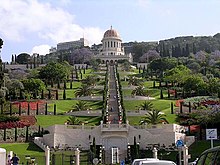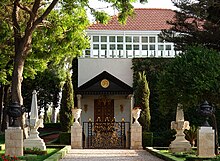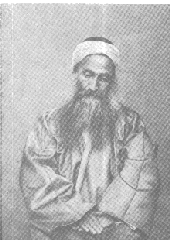History of the Baha'i Religion
The history of the Baha'i religion begins with the revelation of Sayyid Ali Muhammad, called "the Bab " (Arabic: "The Gate"), the founder of Babism . The second important person is Mirza Husayn Ali Nuri, called " Baha'u'llah " (Arabic: "Glory of God"), the founder of the Baha'i religion. The prehistory begins with the work of Sheikh Ahmad al-Ahsā'ī and Sayyid Kāzim Rashti in Sheikhism .
Shaykhism
Sheikhism is a reform movement within Islam whose followers, awaiting the Last Judgment , went in search of the Mahdi , the successor of Muhammad .
Ahmad al-Ahsā'ī
Sheikh Ahmad al-Ahsā'ī was born in 1753 in al-Hasa , a historical region in the east of what is now Saudi Arabia , and founded Sheikhism. He named Sayyid Kāzim Rashti as his successor, but left Shaykhism two years before his death and died in 1826.
Sayyid Kāzim Rashti
Sayyid Kāzim Raschti was born in 1793 in Rascht , a city in what is now northern Iran . He died between December 31, 1843 and January 2, 1844. His followers went in search of the Mahdi and Mulla Husayn saw Sayyid Ali Muhammad as the Mahdi, who then revealed himself to him.
Babism
The Bab

Sayyid Ali Muhammad was born on October 20, 1819 in Shiraz , Iran. On the evening of May 22, 1844, he first claimed to be a messenger of God. For his title he chose the Shiite eschatological term "Bab", which means gate, and interpreted it to mean "Gate to God", thus claiming to be a post-Mohammedan prophet and the pioneer of a subsequent God revelator. As a result, some Shiites became aware of Babism and became followers of Bab. Nevertheless, Shiite scholars and clergy rejected the claim and revelation of the Bab as well as his interpretation of Islam, since the Bab questioned the role of religious scholars and advocated equal rights for women. He was then arrested in early 1847.
As a result of a council of influential supporters of the Bab, the official separation from Islam was finally completed in July 1848 in Badashht on the Caspian Sea .
As a result of the increasing missionary activity of the Babis, resistance quickly arose from Shiite groups and the first state-organized persecutions. As a result, some Babis revolted against the Iranian government, since the idea of jihad was preserved in the early days. Finally, the Bab was publicly executed in Tabriz on July 9, 1850 , but the persecution continued until 1853, killing thousands of Babis.
From 1848 two of Bab's followers became very important: the sons of a state minister in Tehran and half-brothers Mirza Husayn Ali Nuri, later called Baha'u'llah, and Mirza Yahya Nuri, later called Subh-i-Azal. The Bab had decreed that the then nine-year-old Subh-i-Azal would take over the leadership of the Babis, but he was hardly able to do so. Thereupon Baha'u'llah and other Babis proposed him and the Bab appointed Baha'u'llah in 1849 until the appearance of "He whom God will reveal", the messianic figure expected in Babism , as administrator.
Subh-i-Azal
Mirza Yahya Nuri was born in Tehran in what is now Iran in 1831 or 1832 . From 1848 he and his half-brother Mirza Husayn Ali Nuri, later called Baha'u'llah, gained importance among the Babis. The Bab had decreed that the then nine-year-old Subh-i-Azal should take over the leadership of the Babis, but he was hardly able to do so. Thereupon Baha'u'llah and other Babis proposed him and the Bab appointed Baha'u'llah in 1849 until the appearance of "He whom God will reveal", the messianic figure expected in Babism , as administrator. Subh-i-Azal fled the persecution in Iran to Baghdad in the Ottoman Empire to Baha'u'llah in 1853 . Although the latter asked him to go back to Persia, Subh-i-Azal stayed in Baghdad. When Baha'u'llah was exiled to Edirne and Istanbul in 1863, his half-brother followed him here too. When Baha'u'llah there publicly made his claim to revelation for this age, Subh-i-Azal responded with his claim to an independent revelation from God. Since then, the followers have called themselves Subh-i-Azal after him Azali and tried to prevail against Baha'u'llah and get rid of him. The Ottoman government then banished the half-brothers into separate exiles: Baha'u'llah was exiled to Acre in Palestine and Subh-i-Azal to Famagusta in Cyprus , where he died on April 29, 1912.
Bahai
Baha'u'llah

Mirza Husayn Ali Nuri was born on November 12, 1817 in Tehran in what is now Iran as the son of the Persian civil servant Mirza Buzurg. He was offered to follow his father's career, but he declined. He preferred to devote himself to poor relief and spiritual issues. In 1844 he joined Babism after receiving a scroll from the first follower of Bab, Mulla Husayn Bushru'i , and learning of this new revelation. Although he quickly became one of the most important Babis, he never met the Bab in person.
Baha'u'llah chaired the Badashht Conference from June to July 1848 , at which it should be clarified whether Babism should be a reform movement of Islam or an independent religion. The result was a complete split from Islam, which was Baha'u'llah's will and was confirmed by the Bab from his captivity. As a result, the persecution against the Babis intensified and culminated in the public execution of Bab on July 9, 1850 in Tabriz.
As a result of the persecution, Baha'u'llah was incarcerated in Tehran's Siyah-Chal ("Black Hole") prison in 1852. Many of his fellow inmates were executed, but Baha'u'llah was not executed because he enjoyed a great public reputation and Western ambassadors stood up for him. The Baha'i see the mystical experiences of Baha'u'llah beginning there as the beginning of his revelation.
As a result of his illnesses suffered in Tehran prison, Baha'u'llah was sent into exile in Baghdad, where Subh-i-Azal and other Babis followed him. There the first tensions arose between the half-brothers and Baha'u'llah then withdrew to the Kurdish mountainous region of the Silêmanî province . When he returned to Baghdad, he quickly gained prestige and influence, which the Persian consul displeased and thereupon obtained the banishment to Istanbul.
Before his departure, Baha'u'llah declared on April 8, 1863 in the garden of Ridvan to some of his followers that he would be "the God promised" by the Bab. Baha'u'llah was exiled from Istanbul to Edirne, where he publicly raised his claim from the spring of 1866 and wrote letters to the most important rulers of the time. As a result of the ensuing dispute between Baha'u'llah and Subh-i-Azal, Baha'u'llah was exiled to Acre in Palestine, where he arrived on August 31, 1868. Here he wrote further letters to important rulers and the Kitab-i-Aqdas , the "holiest book". For the next few years he lived in Mazra'ih and Bahji, north of Acre.
Baha'u'llah died on May 29, 1892 in Bahji near Haifa in Israel, where the spiritual center of the Baha'i community is today.
Abdu'l Baha
Abbas Effendi was born on May 23, 1844 in Tehran in what is now Iran as the eldest son of Baha'u'llah. Baha'u'llah had decreed in his will that Abdu'l Baha should take over the leadership of the Baha'i community and was appointed interpreter. Abdu'l Baha spent over 60 years in captivity at his father's side and was only released as a result of the Young Turkish Revolution in 1908. From 1919 to 1913 he visited the congregations founded in North America in 1892, where the foundation stone for the House of Worship near Chicago was laid in his presence , and Europe, where he visited Germany in the spring of 1913. He achieved great public recognition for his humanitarian commitment, especially during the First World War, and was knighted by the British Empire . Abdu'l Baha died on November 28, 1921 in Haifa, Palestine and was buried with great public sympathy.
Shoghi Effendi
Shoghi Effendi was born on March 1, 1897 in Acre in what is now Israel. In his will, Abdu'l Baha named his grandson Shoghi Effendi as the “guardian” of the Baha'i community. Shoghi Effendi translated into English some of the most important writings of Baha'u'llah and was the last appointed interpreter. under his leadership the Baha'i community spread to almost every country in the world. He bought land on Mount Carmel for the Baha'i World Center with the shrine of Bab. Shoghi Effendi obtained the establishment of local and national spiritual councils and prepared the election for the first house of justice . On November 4, 1957 Shoghi Effendi died suddenly at the Asian flu in London in the United Kingdom .
Universal House of Justice
Since the first election of the members of the House of Justice in 1963, the House has led the international congregation and adopted the statutes in 1972. In July 2008, the Bahai World Center , where the House of Justice has been based since 1983, was named a World Heritage Site .
See also
Individual evidence
- ^ A b c Dennis MacEoin: Encyclopædia Iranica . Oxford, UK 1989.
- ↑ a b c Nabíl-i-Zarandí: The Dawn-Breakers: Nabíl's Narrative . Bahá'í Publishing Trust, Wilmette, Illinois, USA 1932, ISBN 0-900125-22-5 , pp. 16 ( The Dawn-Breakers ).
- ↑ Armin Eschraghi: The claim of Bab in his early writings . In: Contributions from the Irfan Colloquium 2004 . Hofheim 2005, ISBN 3-87037-437-3 , p. 47-81 .
- ^ Todd Lawson, The Terms 'Remembrance' and 'Gate' in the Bab's Commentary of the Sura of Joseph . In: Momen (Ed.): Studies in the Babi and Baha'i Religions . Volume 5. Los Angeles 1988, pp. 1 ff .
- ↑ Abbas Amanat: Resurrection and Renewal. The Making of the Babi Movement in Iran, 1844-1850 . Cornell University Press, Ithaca / London 1989, ISBN 0-8014-2098-9 .
- ↑ M. Momen: BADAŠT . In: Ehsan Yarshater (Ed.): Encyclopædia Iranica (English, including references)
- ↑ Manfred Hutter: The world religions . 2nd Edition. CH Beck, Munich 2006, ISBN 978-3-406-50865-3 , p. 106 .
- ↑ Gunnar Heinsohn : Lexicon of Genocides . Rowohlt, 1998, ISBN 3-499-22338-4 , pp. 87 .
- ↑ Theologische Realenzyklopädie , Vol. 5, keyword Baha'ism, p. 117; on the whole: Nicola Towfigh: Some aspects of the Babi and Baha'i history . In: Udo Schaefer et al. (Ed.): Disinformation as a method. The Bahā ʾ īsmus monograph by F. Ficicchia . Religious studies texts and studies, vol. 6. Georg Olms Verlag , Hildesheim 1995, ISBN 3-487-10041-X , p. 478 ff., 503 ff .
- ↑ Theologische Realenzyklopädie , Vol. 5, keyword Baha'ism, p. 117; on the whole: Nicola Towfigh: Some aspects of the Babi and Baha'i history . In: Udo Schaefer et al. (Ed.): Disinformation as a method. The Bahā ʾ īsmus monograph by F. Ficicchia . Religious studies texts and studies, vol. 6. Georg Olms Verlag, Hildesheim 1995, ISBN 3-487-10041-X , p. 478 ff., 503 ff .
- ↑ a b Momen, Moojan: Baha'u'llah. A Short Biography . Oneworld Publications, Oxford 2007, ISBN 978-1-85168-469-4 , pp. 13 .
- ↑ Momen, Moojan: Baha'u'llah. A Short Biography . Oneworld Publications, Oxford 2007, ISBN 978-1-85168-469-4 , pp. 16-19 .
- ↑ a b c Cole, Juan, BAHÁ-ALLÁH MÍRZA HOSAYN-ALI NÚRÍ . Encyclopædia Iranica
- ↑ Kent Beveridge: Early Encounters of Central Europe with Baha'i History . Publication series of the Society for Bahá'í Studies, Vol. 1. Hofheim 1995, ISBN 3-87037-311-3 , pp. 9 f .
- ↑ Alessandro Bausani : Keyword Bahā Allāh . In: Encyclopaedia of Islam . tape 1 . Brill, Leyden / London 1960, pp. 911 .
- ^ The Bahá'í Faith . In: Encyclopaedia Britannica (ed.): Britannica Book of the Year . Chicago 1988, ISBN 0-85229-486-7 .
- ↑ Article Bahāʾ-Allāh in Encyclopædia Iranica , p. 426 of the printed edition (Vol. 3); see in particular Baha'u'llah: Súratu'l-Mulúk and the Súratu'l-Haykal . In: Claim and Annunciation. Letters from Edirne and 'Akká . Hofheim 2007, ISBN 978-3-87037-419-8 .
- ↑ cf. Baha'u'llah, Kitab-i-Ahd , in messages from Akka , Hofheim 1982; see also Manfred Hutter: Holy Scriptures of the Baha'i . In: Udo Tworuschka (Ed.): Holy Scriptures, An Introduction . S. 266 f .
- ↑ Manfred Hutter: Holy Scriptures of the Baha'i . In: Udo Tworuschka (Ed.): Holy Scriptures, An Introduction . S. 268 f .
- ^ Keyword expansion . In: Peter Smith (Ed.): A Concise Encyclopedia of the Bahá'í Faith . Oxford 2000, ISBN 1-85168-184-1 .
- ^ Three new sites inscribed on UNESCO's World Heritage List. UNESCO World Heritage Center, July 8, 2008, accessed October 16, 2009 .
- ^ Convention concerning the protection of the world cultural and natural heritage. (PDF; 512 kB) World Heritage Committee, June 2, 2007, p. 34 , accessed on October 16, 2009 (English).
literature
- National Spiritual Council of Bahá'ís in Germany (Ed.): 100 Years of the German Bahá'í Congregation. 1905-2005 . Bahá'í-Verlag, Hofheim 2005, ISBN 3-87037-436-5 .
- Johann Christoph Bürgel, Isabel Schayani (Ed.): Iran in the 19th century and the emergence of the Bahā'ī religion . Georg Olms Verlag, Hildesheim, Zurich, New York 1998, ISBN 3-487-10727-9 ( online as preview at Google Books ).
- Cameron, G. & Momen, W .: A Basic Bahá'í Chronology . George Ronald, Oxford, UK 1996, ISBN 0-85398-404-2 .
- Peter Smith: A Concise Encyclopedia of the Bahá'í Faith . Oneworld Publications, Oxford, UK 1999, ISBN 1-85168-184-1 .
- Peter Smith: The Bahá'í Faith. A short history . Oneworld Publications, Oxford 1999, ISBN 978-1-85168-208-9 .
- Peter Smith: The Babi and Baha'i Religions. From messianic Shi'ism to a World Religion . Cambridge University Press, Cambridge, New York 1987, ISBN 0-521-31755-X .
Web links
- Timelines, Genealogies, Chronologies
- Bahá'i Chronology ( Memento of August 15, 2003 in the Internet Archive )
- Bibliography for the Tablets of Baha'u'llah: List of citations and resources for Tablets revealed 1853-1863 (first of four sections)
- First Public Mentions of the Bahá'í Faith ( Memento of October 20, 2012 in the Internet Archive ) prepared by the Bahá'í Information Office (United Kingdom) for the UK. Bahá'í Centenary 1998-99 and is based on research and articles by Dr Moojan Momen (Bahá'í Journal, September 1989) and Derek Cockshutt (Bahá'í Journal, March 1993).




